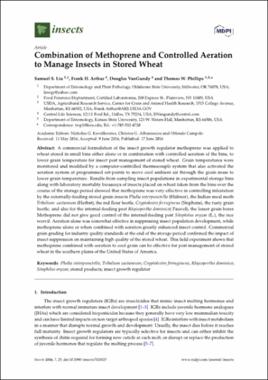| dc.contributor.author | Liu, Samuel S. | |
| dc.contributor.author | Arthur, Frank H. | |
| dc.contributor.author | VanGundy, Douglas | |
| dc.contributor.author | Phillips, Thomas W. | |
| dc.date.accessioned | 2019-09-25T18:24:39Z | |
| dc.date.available | 2019-09-25T18:24:39Z | |
| dc.date.issued | 2016-06-17 | |
| dc.identifier | oksd_liu_combinationofme_2016 | |
| dc.identifier.citation | Liu, S. S., Arthur, F. H., VanGundy, D., & Phillips, T. W. (2016). Combination of methoprene and controlled aeration to manage insects in stored wheat. Insects, 7(4). https://doi.org/10.3390/insects7020025 | |
| dc.identifier.uri | https://hdl.handle.net/11244/321429 | |
| dc.description.abstract | A commercial formulation of the insect growth regulator methoprene was applied to wheat stored in small bins either alone or in combination with controlled aeration of the bins, to lower grain temperature for insect pest management of stored wheat. Grain temperatures were monitored and modified by a computer-controlled thermocouple system that also activated the aeration system at programmed set-points to move cool ambient air through the grain mass to lower grain temperature. Results from sampling insect populations in experimental storage bins along with laboratory mortality bioassays of insects placed on wheat taken from the bins over the course of the storage period showed that methoprene was very effective in controlling infestation by the externally-feeding stored grain insects Plodia interpunctella (Hübner), the Indian meal moth Tribolium castaneum (Herbst), the red flour beetle, Cryptolestes ferrugineus (Stephens), the rusty grain beetle, and also for the internal-feeding pest Rhyzopertha dominica( Fauvel), the lesser grain borer. Methoprene did not give good control of the internal-feeding pest Sitophilus oryzae (L.), the rice weevil. Aeration alone was somewhat effective in suppressing insect population development, while methoprene alone or when combined with aeration greatly enhanced insect control. Commercial grain grading for industry quality standards at the end of the storage period confirmed the impact of insect suppression on maintaining high quality of the stored wheat. This field experiment shows that methoprene combined with aeration to cool grain can be effective for pest management of stored wheat in the southern plains of the United States of America. | |
| dc.format | application/pdf | |
| dc.language | en_US | |
| dc.publisher | MDPI | |
| dc.rights | This material has been previously published. In the Oklahoma State University Library's institutional repository this version is made available through the open access principles and the terms of agreement/consent between the author(s) and the publisher. The permission policy on the use, reproduction or distribution of the material falls under fair use for educational, scholarship, and research purposes. Contact Digital Resources and Discovery Services at lib-dls@okstate.edu or 405-744-9161 for further information. | |
| dc.title | Combination of methoprene and controlled aeration to manage insects in stored wheat | |
| osu.filename | oksd_liu_combinationofme_2016.pdf | |
| dc.description.peerreview | Peer reviewed | |
| dc.identifier.doi | 10.3390/insects7020025 | |
| dc.description.department | Entomology and Plant Pathology | |
| dc.type.genre | Article | |
| dc.type.material | Text | |
| dc.subject.keywords | plodia interpunctella | |
| dc.subject.keywords | tribolium castaneum | |
| dc.subject.keywords | cryptolestes ferrugineus | |
| dc.subject.keywords | rhyzopertha dominica | |
| dc.subject.keywords | sitophilus oryzae | |
| dc.subject.keywords | stored products | |
| dc.subject.keywords | insect growth regulator | |
